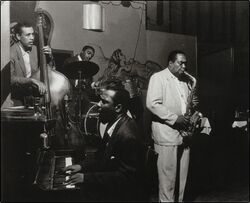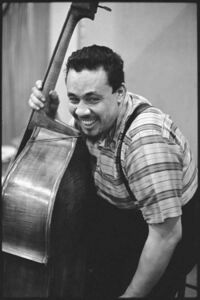Charles Mingus
Charles Mingus Jr. (April 22, 1922 – January 5, 1979) was the biggest, brashest, bastardest bassist in the history of jazz music. His technical skill at both composition and performance was rivaled only by his rage and temper behind the scenes, itself only rivaled by his rage and temper in front of (and during) the scenes. In fact, it was often Mingus himself who made the scenes, while his bandmates ineffectually told him to stop, since they were starting to draw a crowd.
Early life
Charles Mingus was born a poor black child in Nogales, Arizona, brother to Steve Mingus and Martin Mingus. Thanks to the educational efforts of his parents Mindy Mingus and Mork Mingus, young Charlie learned at a very young age the power of music, the importance of family, and the hatred of the white man. Though he was enrolled in a special middle school for gifted musicians, his professors thought he would be limited by the color of his skin and adjusted his curriculum appropriately. Mingus quickly grew tired of having to make extra blackface runs for Minstrelsy 102 while all his friends were studying for The Joy of Beethoven.
In a pivotal moment for his musicianship, Mingus quit the school with all the indignation that a 12-year-old could muster: by flipping his principal's desk and spitting in his face. By the time the latter reached for a tissue to clean up the mess, Mingus had already boarded the first bus to New York to begin his long, fruitful, furious jazz career.
Discovering the Gift
Mingus had a strong desire to play the violin since his youth, so he purchased one as soon as the Greyhound touched down in New York. While he showed a knack for the instrument, the frustration of a simple mistake would send the small, fragile instrument careening into the wall in a magnificent flourish of splinters. Talent scouts were impressed with his playing, but fearful of his pugnacity; he was accepted into Bronx Academy of the Arts magnet school on the condition that he stop playing instruments that were so easy to snap in half. Not wanting to abandon his favorite instrument, but also unwilling to wrack up an inconceivable debt from shattering instruments a la Milton Babbitt's oboe fiasco, Mingus conceded to the Bronx brass by switching to brass.
One fateful November evening, an awestruck janitor walked in on Mingus completely unraveling a French Horn after a botched attempt of Nikolai Rimsky-Korsakov's "Flight of the Bumblebee." After days of heated discussion, Mingus was forcibly switched into a non-instrumental composition program. Mingus protested this decision by threatening to beat the Board of Directors to death with a cello. Mingus, further infuriated by the board's attempt to appease him with whipped cream and gummy bears, dropped the cello in favor of the deadlier double bass, only to discover he had some trouble lifting it over his 14-year-old head. A compromise was reached out of this serendipitous occasion.
Charlie's Wild Years
After spending the summer searching for a tutor who didn't lose his bowels every time Mingus gave him a bad glance, the precocious scamp decided to give up and teach himself the tools of the trade. Frustrated with the summer's follies, Mingus grabbed a pen and scribbled down hundreds of notes on a piece of paper, occasionally snapping his pen in half and tearing through the paper into the oak table below. Beneath the ink puddles and splinters, his first jazz masterpiece was born.
With this piece, "Sunday Night Pudding Fight", as the backbone of his resume, Mingus applied to and was accepted by the prestigious Brubeck University, where jazz goes to college. Mingus entered a special program for enraged musicians, taught by trumpet legend Charlie "Bird" Parker, who (sometimes) channeled his own heroin-fueled apoplexy into works of art. To help translate anger into art, Parker taught Mingus the techniques of bebop, a fast and furious style of jazz that originated when Dizzy Gillespie had an epileptic fit during a concert, impressing the crowd with his ostensible improvised madness.
The young buck was so influenced by Parker's lessons that his compositions could be clearly divided into being "Pre-Bird," and "Post-Bird." Many Post-Bird compositions are defined by their focus on virtuosity and emotive expression; Pre-Bird compositions are easily identifiable by their shredded paper, repeated choruses of "FUCK THIS NOISE," and occasional blood stains.
The Leader of a Big Ol' Band
Mingus rose to notoriety when he became the primary composer for Brubeck U's marching band. During his one-year tenure, he composed career staples such as "Pugnathropus Erectus" and "Haitian Fight Song." The tunes themselves functioned poorly as actual fight songs, enthralling to the point of severe distraction, and the Brubeck Fifty-Four-ers finished the season 4 - 33. Mingus emerged the real victor, scoring two hits and a record contract for Atlantic.
As he continued to grow as a bandleader over the years, releasing an unbroken stream of critically acclaimed albums between 1959 and 1972, Mingus also gradually grew out of his youthful truculence. Since 1959, he has only monumentally lost his cool on several special occasions, each more often than not yielding a landmark album.
Mingus Ah Um
Renowned musicologist and self-proclaimed Mingus specialist Clarence Talboys speculates that the enormous tantrum thrown during the Mingus Ah Um sessions "broke, annihilated, devastated, simply demolished, nay, completely and totally obliterated Mingus's boiling psyche, unleashing three years of pent-up fury upon the world, like a vengeful child breaking out of his stepfather's oven."
The mediocre reception of his prior album East Coasting prompted Atlantic to unceremoniously drop him from the label in 1956. Mingus, under the advice of his psychiatrist, locked away his lead pipe and started some therapeutic composing. Trauma paid remarkable dividends, and Mingus wrote some of the best work of his life; in 1958, Columbia gave him a dream contract with free choice of musicians. After all the parts were played, it looked to be the most fully realized record Mingus, and perhaps the entire jazz world, would ever release. All it needed was a title.
"It was like trying to name God, it was just impossible," said saxophonist Booker Ervin, who had never met a jew or a muslim in his life. A fruitless night of brainstorming later, Mingus had it. Menacingly wielding a clarinet katana and cymbal shield, he finally exploded:
| “ | Okay! Nope! That's fucking IT! We're not looking into the fucking Ark of Covenant here, we're not naming a fucking baby here, we're not fucking christening a goddamn racetrack with a fucking bottle of champagne here. Do you see any champagne? I DON'T SEE ANY FUCKING CHAMPAGNE. Jesus Fuck, we did some wonderful work but did we witness the birth of Mary and Mohammad's fucking love child? I did my fucking part WRITING this masterpiece, is it too much to ask some of my WORTHLESS, BEST FRIENDS to maybe SLAP A NAME ON IT? I think I still have fucking CUM stuck in my ears from how great it sounded, but holy SHIT you idiots are USELESS at naming albums. Might as well just call it "Ahhhhhh ummmmmmm I DUNNO I'M A FUCKING STILLBORN RETARD" because THAT'S ALL I'VE HEARD FROM YOU INSIDE-OUT ASSHOLES IN THE LAST FIVE AND A HALF HOURS. Hey, I have a BRILLIANT idea, maybe I will call it that! Yeah, and I'll make up super pretentious reasons for it in the interviews. "You see, Mr. Koppel, the "Ah" is symbolic of the saxophone's screaming riff on 'Boogie Stop Shuffle,' the 'Um' is actually a metavisual representation of society's political indecision, and the 'MY BAND IS FULL OF FUCKING STILLBORN RETARDS' is symbolic of my USELESS PIECE OF SHIT BAND." | ” |
Columbia wouldn't let him keep the last part, but everything else was a-okay.
The Black Saint and the Sinner Lady
The success of Mingus Ah Um made Mingus a critical legend, but his emotional outburst offered little catharsis. Instead, it only added to the volcanic eruption that occurred during the Black Saint and the Sinner Lady sessions.
Mingus, based on his past experience, planned out a title for the forthcoming album, Three-Bean Salad For Five, before recording started. Unfortunately, the best laid plans of Mingus and men fell apart with a single quip. One fateful Wednesday, his wife Mrs. Sue Mingus paid a visit to the studio in an absolutely horrific blouse, prompting sassy homosexual trumpeter Quentin Jackson to proclaim "Oh me oh my, that shirt is simply a sin!" Mingus, already fed up with Jackson's excessive fancy of mixolydian modality, rearranged the entire production to spite the session musician. He briefly took a moment to rearrange his face, too.
Jackson wouldn't take such assault lying down—except for the parts when he was unconscious—and Mingus found himself faced with several arrest warrants, including one for aggravated gay bashing. Infuriated that someone had the gall to challenge his fury, Mingus took his indignation out on the remaining members of his band, sending saxophonist Jerome Richardson into a three day coma. The beating of Richardson, a straight man, was enough to drop the "hate crime" angle. Gathering evidence for the case, detectives at last saw Mrs. Mingus's horrible shirt with their own eyes; out of sympathy for the fashion-challenged woman and her burden-bearing husband, all charges against the man were dropped.
Mingus remained angry and clever as ever, passive-aggressively renaming the album The Black Saint and the Sinner Lady, aggressive-passively inviting Jackson back to the studio, and aggressive-aggressively forcing him to play his part while in a headlock. As a coup de grace, he replaced the existing liner notes with a conversation with his psychotherapist, in which they discussed the cathartic ecstasy one gets when pummeling a man's kidneys with marimba sticks.
Death
Mingus continued to make ahead-of-the-curve jazz for years, but sparing the occasional violent outburst at a concert or Denny's, critics noted that he seemed to be lacking the spontaneous passion that characterized his earlier works. Most speculate that he secretly internalized all his anger so he could use it on a late-period composition appropriately called Epitaph.
Mingus died in 1979 from the world's largest aneurysm before the composition could go public. Therefore, its existence remained a secret until 1984, when jazz archaeologists discovered it underneath a massive pile of stress balls and voodoo dolls. Since the unearthing, orchestras all over the world have attempted to play the piece, which, at over 4000 measures in length, is the longest jazz composition ever. Unfortunately, such attempts have seen little success; most orchestras give up at measure 3514, which demands a ritual sacrifice of three tenor saxophonists, or 2162, which requires the conductor to strangle himself while three of his closest enemies look on in the front row.
No one is quite sure what brutal inequities drove Mingus to compose such a sprawling, daring piece, even leaving speculation-prone historians without enough context for wild mass guessing. If only Mingus were alive today, we could fully understand and appreciate what drove the man to pursue such grotesque, wonderful limits in his later days. If only.
| Featured version: 11 January 2012 | |
| This article has been featured on the main page. — You can vote for or nominate your favourite articles at Uncyclopedia:VFH. | |






